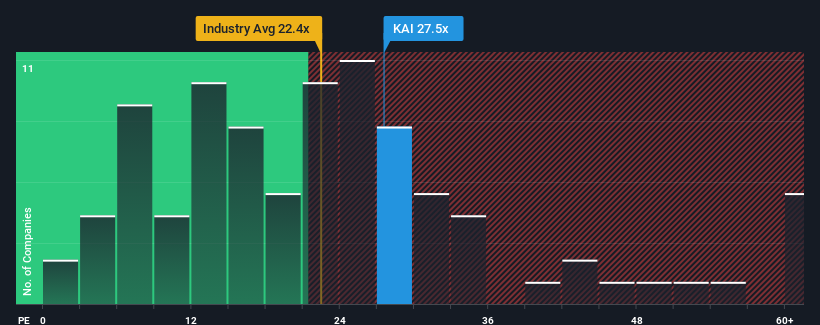
When close to half the companies in the United States have price-to-earnings ratios (or "P/E's") below 16x, you may consider Kadant Inc. (NYSE:KAI) as a stock to avoid entirely with its 27.5x P/E ratio. Although, it's not wise to just take the P/E at face value as there may be an explanation why it's so lofty.
With earnings that are retreating more than the market's of late, Kadant has been very sluggish. It might be that many expect the dismal earnings performance to recover substantially, which has kept the P/E from collapsing. You'd really hope so, otherwise you're paying a pretty hefty price for no particular reason.
See our latest analysis for Kadant

How Is Kadant's Growth Trending?
In order to justify its P/E ratio, Kadant would need to produce outstanding growth well in excess of the market.
Retrospectively, the last year delivered a frustrating 3.9% decrease to the company's bottom line. However, a few very strong years before that means that it was still able to grow EPS by an impressive 135% in total over the last three years. So we can start by confirming that the company has generally done a very good job of growing earnings over that time, even though it had some hiccups along the way.
Looking ahead now, EPS is anticipated to slump, contracting by 0.2% during the coming year according to the five analysts following the company. With the market predicted to deliver 10% growth , that's a disappointing outcome.
With this information, we find it concerning that Kadant is trading at a P/E higher than the market. Apparently many investors in the company reject the analyst cohort's pessimism and aren't willing to let go of their stock at any price. There's a very good chance these shareholders are setting themselves up for future disappointment if the P/E falls to levels more in line with the negative growth outlook.
What We Can Learn From Kadant's P/E?
It's argued the price-to-earnings ratio is an inferior measure of value within certain industries, but it can be a powerful business sentiment indicator.
We've established that Kadant currently trades on a much higher than expected P/E for a company whose earnings are forecast to decline. When we see a poor outlook with earnings heading backwards, we suspect the share price is at risk of declining, sending the high P/E lower. Unless these conditions improve markedly, it's very challenging to accept these prices as being reasonable.
Many other vital risk factors can be found on the company's balance sheet. Take a look at our free balance sheet analysis for Kadant with six simple checks on some of these key factors.
Of course, you might also be able to find a better stock than Kadant. So you may wish to see this free collection of other companies that have reasonable P/E ratios and have grown earnings strongly.
Valuation is complex, but we're here to simplify it.
Discover if Kadant might be undervalued or overvalued with our detailed analysis, featuring fair value estimates, potential risks, dividends, insider trades, and its financial condition.
Access Free AnalysisHave feedback on this article? Concerned about the content? Get in touch with us directly. Alternatively, email editorial-team (at) simplywallst.com.
This article by Simply Wall St is general in nature. We provide commentary based on historical data and analyst forecasts only using an unbiased methodology and our articles are not intended to be financial advice. It does not constitute a recommendation to buy or sell any stock, and does not take account of your objectives, or your financial situation. We aim to bring you long-term focused analysis driven by fundamental data. Note that our analysis may not factor in the latest price-sensitive company announcements or qualitative material. Simply Wall St has no position in any stocks mentioned.
About NYSE:KAI
Excellent balance sheet with questionable track record.
Similar Companies
Market Insights
Community Narratives




